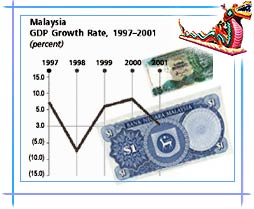Fiscal year - Calendar year
Trade organizations - APEC, ASEAN, WTO
GDP ranking - 34th (2007)
Malaysia is though a small and rather open economy; it has great economic statistical prospects. For centuries, Malaysia has been a centre for trade and commercial activities. In the 17th century, items like porcelain and spices were found in several Malay states which were further used for trading purposes. When the British became the administrators of Malaya, Rubber and palm oil trees were also introduced for business reasons.
Eventually, Malaysia developed into the world's largest producer of tin, rubber, and palm oil. And these three commodities, together with other raw materials, established the country's economic tempo in the mid-20th century. In place of local Malays, the British brought in Chinese and Indians as labors to work on the mines and
 plantations.
Moving towards independence, the Malaysian Government started economic
five-year plans and initiated with the First Malayan Five Year Plan in
1955.
plantations.
Moving towards independence, the Malaysian Government started economic
five-year plans and initiated with the First Malayan Five Year Plan in
1955. With an idea to imitate Asian Tigers, Malaysia committed itself for an evolution that would stress on manufacturing rather than mining and agriculture in 1970s. Within a few years, heavy industries flourished by means of Japanese investment and exports became the Malaysia's primary growth engine. In the 1980s and 1990s, the country constantly realized more than 7% GDP growth with low inflation.
The economic expansion started contracting during 1997-98 thanks to the Asian financial crisis. With this, the government was strained to reduce expenditure and adjourn many large infrastructure projects. At that time, unemployment and interest rates increased, and innumerable foreign workers were enforced to leave the country. In 1999, Malaysian economy began recovering and regardless of the government's long-term efforts to improve the economic condition of Malays by preferential treatment, the Chinese continued their old governance of the economy.
For some time, currency speculation and steer reduction in FDI tremendously affected the economy. In the early 2000s, there was a boost in electronics components exports which helped the economy to recover. And possibly, there could be many other reasons which can be held responsible for the growth. Soon after, Malaysia recovered faster than its neighboring countries. However, today, the pace of development is not very swift, but it is maintained.
According to the World Bank, the economy of Malaysia falls under East Asia and the pacific region. About 20% of the population depends on agriculture for their livelihood. Where Rice is the staple food, others nutrients are provided by fish. Malaysia is a significant producer of rubber and tin, where other major industries include palm-oil, crude petroleum and petroleum products, electronics, logging, and textiles. With heavy industrialization and increase in foreign investment, Malaysian economy has definitely improved to a great extent.



